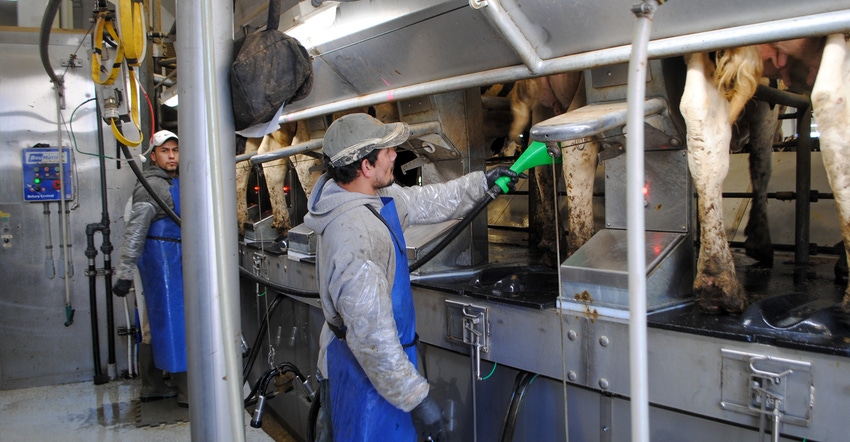
Dairy farmers interested in the Dairy Revenue Protection program available through the American Farm Bureau attended a session on Oct. 4 at World Dairy Expo to learn more about the program and how to sign up.
Sign-up for the program began Oct. 9.
John Newton, chief economist with the American Farm Bureau, explained how the program works, how much it costs and how to sign up.
“Our goal is to see dairy farming becoming profitable by proactively managing risk,” Newton said. “We think this is a product every dairy farmer needs to make a part of their risk management program.”
According to Newton, higher levels of Dairy Revenue Protection coverage are affordable and could range from 10 cents to 30 cents per cwt, depending on the quarter insured. Nearby quarters will be more affordable than distant quarters, and policies with higher deductibles or lower values of milk insured will be more affordable but at the expense of less risk management protection. When combined with the USDA Farm Service Agency’s improved Margin Protection Program, dairy farmers will have a true dairy safety net.
“The Dairy Revenue Protection program is an insurance program that will be managed similarly to crop insurance,” Newton said.
Dairy RP can be purchased by the quarter:
• January through March
• April through June
• July through September
• October through December
Dairy farmers can buy coverage for up to five quarters at a time to protect their milk price longer term.
“Producers can cover any amount of milk production for each quarter through an endorsement,” Newton said. “Actual milk sales must be at least 85% of the declared milk under the endorsement. Producers may have multiple endorsements for each quarter.”
Newton said the program works well for farmers with colored breeds and high components.
“Pricing options can be based on Class III or Class IV milk or a combination, and can include components — butterfat, protein and other solids,” he explained.
Newton said the expected price is based on the average CME futures for the covered quarter.
“The producer chooses a coverage level ranging from 70% to 95% of the expected price,” he said. “Most farms will utilize 90% and 95%. It makes more sense to lock in a higher price given the affordability.”
For example, if the expected price is $16.25, choosing 90% coverage is a $14.63 price, whereas 95% coverage is a $15.44 price. In the Dairy RP indemnity calculation, producers can elect to purchase a protection factor ranging from 1.00 to 1.50 in 5% increments.
By the numbers
Newton calculated the following example:
2,000,000 pounds of milk x $13.87 x 1.01 = $280,174
The yield adjustment factor is the actual milk production per cow divided by the expected milk production per cow.
The following example includes the indemnity calculation:
$308,750 - $280,000 = $28,516 x 1.2 = $34,291
While the premiums presented here are for demonstration purposes only, getting a real-time quote is easy with American Farm Bureau Insurance Services. Beginning Oct. 9, farmer-customers with AFBIS-affiliated Farm Bureau insurance companies have access to a mobile application dedicated to Dairy RP.
Newton advises farmers to work closely with their lender and insurance agent and ask questions.
• Applications can be taken immediately.
• Initial expected prices and premiums were available beginning Oct. 9.
• Quarterly endorsements for the first quarter of 2019 through the first quarter of 2020 could be purchased beginning Oct. 9.
• The final date for the purchase of a first quarter 2019 endorsement is Dec. 15.
• The premium is not due at sign-up.
In the following example, the Class III average price from January through March is $15.81; at 90%, the price is $14.23.
If you cover 100,000 pounds of milk at 95%, your expected revenue will be $15,020. At 90%, it will be $14,230.
“The cost of this policy is 11 cents per cwt, or $100 for coverage on 100,000 pounds of milk,” Newton said.
Not all milk is created equal. If your dairy herd has high components, and the milk price is $16.24 for 3.5% fat and you want to cover milk with 3.8% fat and 3.2% protein, it’s covered at a value that reflects the component value.
“This will cost you slightly more per hundredweight for milk with higher fat and protein,” he said.
If you are milking a herd of Jersey cows with a 5% butterfat test and 4% protein test, the milk value would be $21.54 per cwt.
“We’re able to help protect that,” Newton said. “You’re insuring more and paying more.”
While you can sign up for the Dairy RP Program and Margin Protection Program at the same time, you cannot sign up for the Livestock Gross Margin Insurance Plan for Dairy at the same time.
“You can use this and MPP at the same time. You cannot have this and LGM-Dairy at the same time in a quarter,” Newton said.
Farm Bureau insurance-affiliated customers who sign up for Dairy RP will receive an app for their smartphone that includes the Dairy RP calculator, he said. “Other crop insurance agents can sell this policy, but they don’t get the Farm Bureau-developed calculator app,” Newton added.
More information about the program is available at dairyrp.com.
About the Author(s)
You May Also Like






